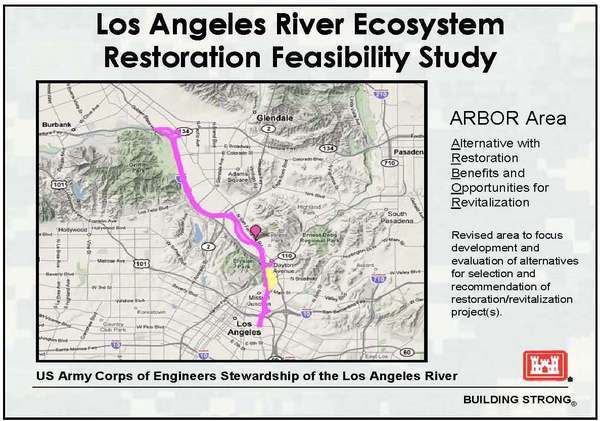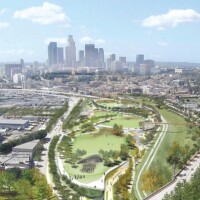An Introduction to the L.A. River Ecosystem Feasibility Study [Updated]

[Update 9/13, 10:00 a.m.: The draft study has been released online. The 500+ page L.A. River Draft Integrated Feasibility Report can be found here.]
These days environmentalists and community groups are watching their inboxes, looking out for an official announcement for the release of results of the Los Angeles River Ecosystem Feasibility Study, expected to be published online this week.
Nicknamed the ARBOR study (for "Alternative with Restoration Benefits and Opportunities for Revitalization"), the report is touted to be the start of ambitious changes to the Los Angeles River, which could affect not just the riverbanks, but the riverbed itself.
The $9.71-million study was initiated in 2006 at the behest of the U.S. Congress. It aims to identify ways in which the ecology could be restored along the river, while still ensuring flood protection for the city. The federal government is paying for half the study and the city, the balance. Once finished, the study's results could be used to begin work on identified projects. The cost of which would be split between the federal and municipal funds at different rates.
The ARBOR study initially looked into the 32-mile stretch of the river between San Fernando Valley and the City of Vernon, but its scope has now focused on the 11-mile portion that connects Griffith Park to downtown Los Angeles. Soft-bottomed in some sections, it is the area the Army Corps has determined to have the greatest potential for eco-system restoration.
The area includes this year's Glendale Narrows Recreational Zone, as well as other sites that have lagged behind in development such as the Arroyo Seco Confluence, Taylor Yard G-2 and Bowtie parcels; and the Cornfields Los Angeles State Historic Park.

The study is expected to lay out four alternatives, which have been trimmed down from 33 options. Though the final study has yet to be published, the flurry has already begun. A front-page story on the Los Angeles Times revealed a few of the options available:
Alternative 13, priced at $444 million, includes concrete removal and restoration on key sites including Taylor Yard.
Alternative 16, priced at $774 million, could see the river widen, with terracing on the riverbanks. It would recommend development of Piggyback Yard, a fraught area owned by Union Pacific Railroad. Difficulties with the landowner have delayed any progress on the site.
Alternative 20, priced at $1.06 billion, encompasses the changes above, but also adds connections to the Cornfields Los Angeles State Historic Park, as well as extensive ecological restoration at Verdugo Wash.
A fourth alternative is also in the works but wasn't discussed further. More expensive alternatives carry a price tag that may reach up to $7 billion.
Cost sharing for the alternative varies, but the article names Alternative 13 as the cheapest. It would also result in the city bearing 70 percent of the total cost, Washington paying for the balance. Other options would see the cost split more evenly, closer to 50-50. Cost estimates released last year indicated that costs of any project would range between $25 to $190 million per mile, depending on the complexity of identified projects.
Speculation is that the Army Corps would endorse the cheapest alternative, which would still result in significant changes to the Los Angeles River ecosystem, but not as much as local city officials would like to see. Already, a resolution is making its way through City Council declaring the city's support for "a Study alternative that results in the most expansive ecosystem restoration."
Once the study is published, it would trigger a 45-day public comment period that will feed into a final report submitted to Congress. The final report would then be the basis for Washington to authorize further investment on the Los Angeles River under the Water Resources Development Act, administered by the Army Corps.
It's estimated that $100-million investment could translate into an equal amount of income, 1,400 construction jobs, not to mention the revitalization of a significant resource for the city.
Stay tuned for updates on this study in the coming weeks.

